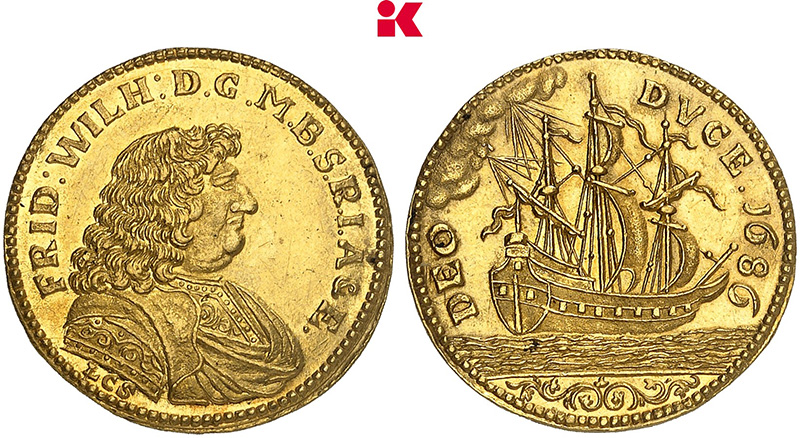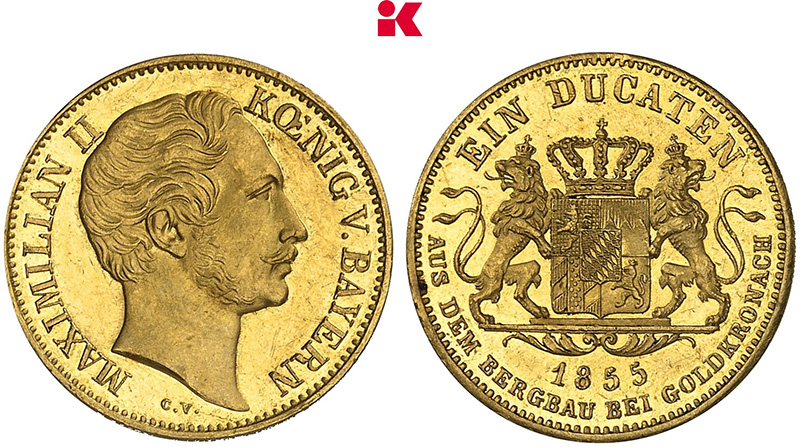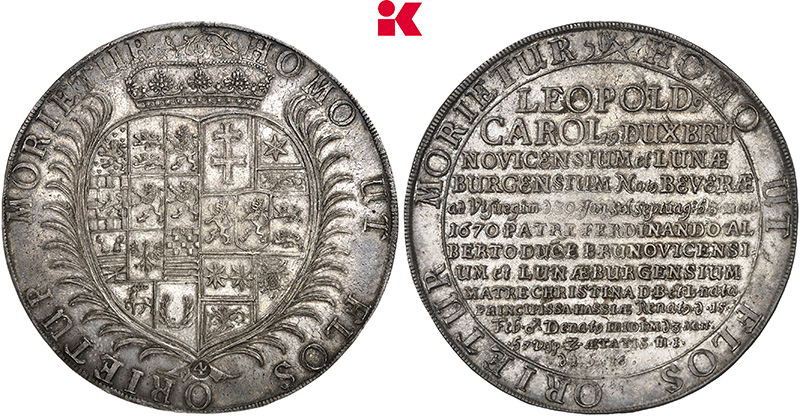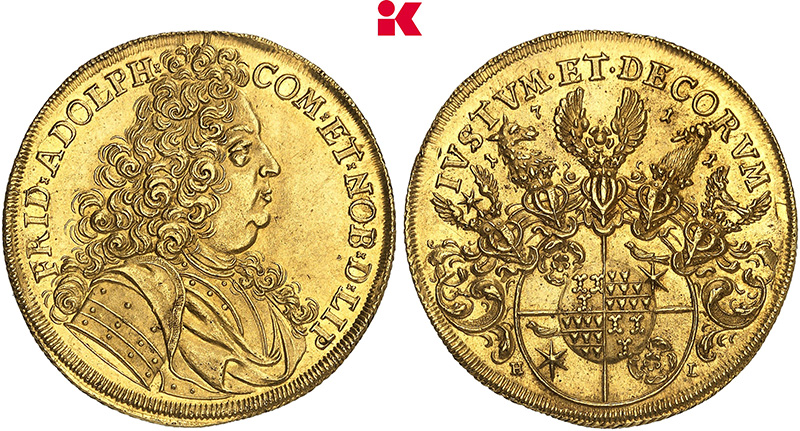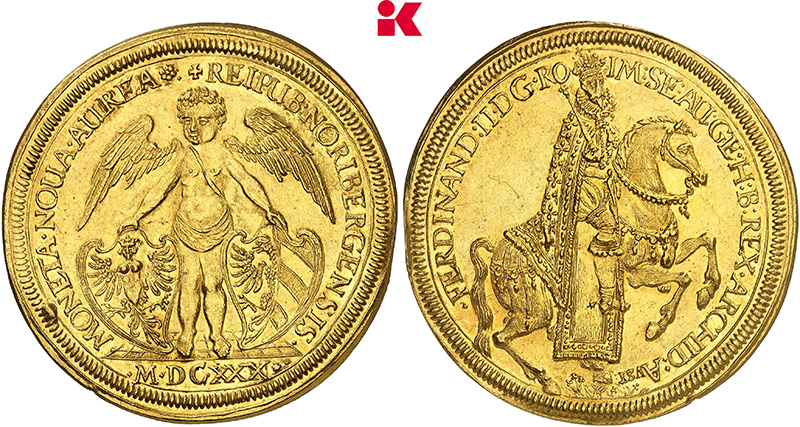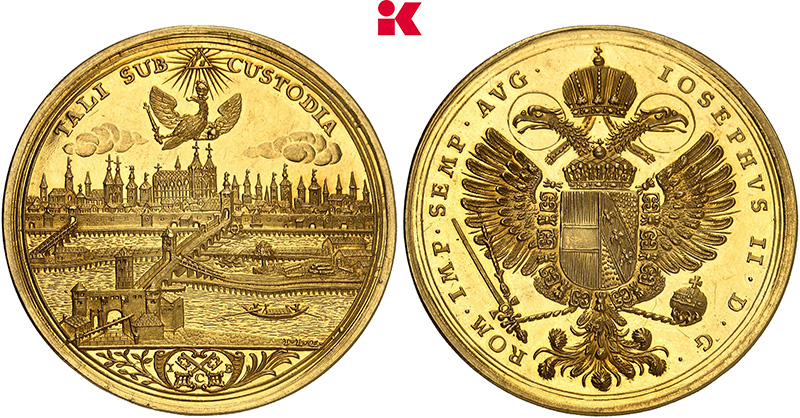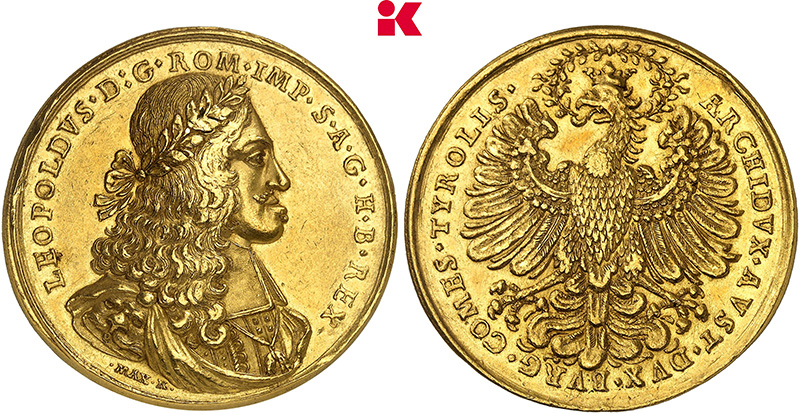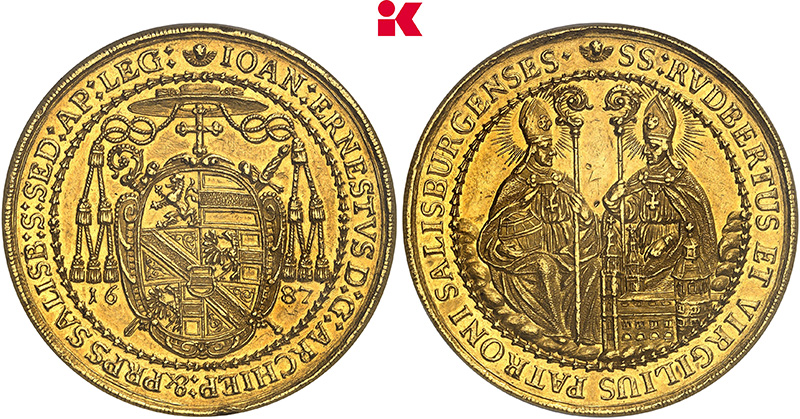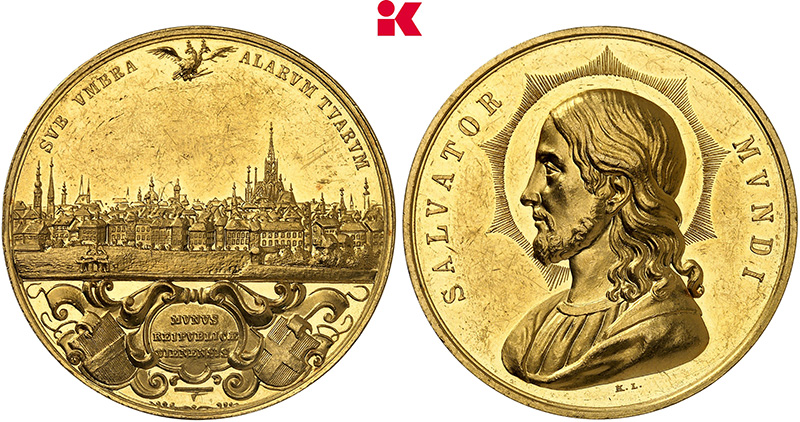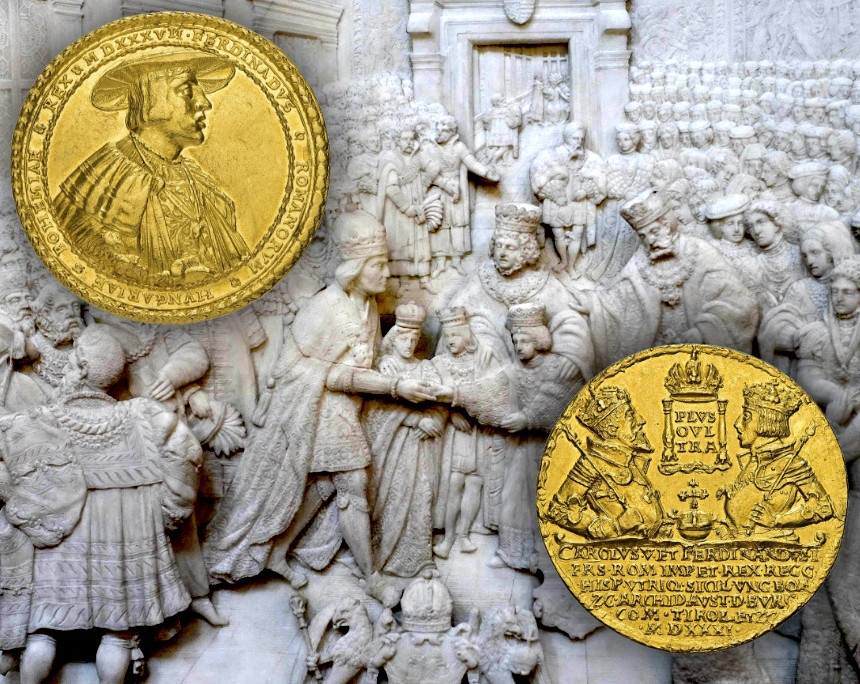The Turks, the Bohemian Estates and Two Gnadenpfennigs by Ferdinand I
SINCONA’s spring auction will be held from 13 to 15 May 2024. Among other highlights, two extremely rare gold gnadenpfennigs by Ferdinand I are on offer. The multiple coins with a weight of 10 and 15 gold gulden are among the great treasures of Habsburg numismatics. We share their story.
Content
On 29 August 1526, disaster struck Hungary. The country’s elite – led by King Louis II – was wiped out in a single battle at Mohacs. Besides the king, 28 magnates and seven high church dignitaries died. The Ottoman army also killed 4,000 cavalrymen, 10,000 foot soldiers, and enslaved some 200,000 inhabitants. In other words: Hungary lost about 5% of its population as a result of this defeat.
The Bohemian Crown
Thus, Hungary was in need of a new king. And not just Hungary. Louis II had also been the ruler of Bohemia and Croatia. The Habsburg Ferdinand laid claim to all three crowns. He invoked the treaty of inheritance that his grandfather, Emperor Maximilian I, had concluded with Vladislav II on the occasion of the double wedding in Vienna. At that time, the rulers had agreed that their offspring would marry: Louis II of Hungary to Maria of Habsburg and Ferdinand I to Anne of Hungary. If either dynasty failed to produce an heir, the other house would take over their rule.
A dynastically promising plan! However, the rulers had ignored the fact that all three kingdoms under the control of Vladislav were elective monarchies. So when Ferdinand learned of his brother-in-law’s death on 9 September 1526, he had to secure the favour of the estates in all three kingdoms. And he had to decide which kingdom had priority.
Bohemia was richer than Hungary, so Ferdinand turned to Bohemia first. He succeeded against two rival candidates. On 23 October 1526, the Bohemian estates elected him king. He was crowned on 24 February, and his wife the following day.
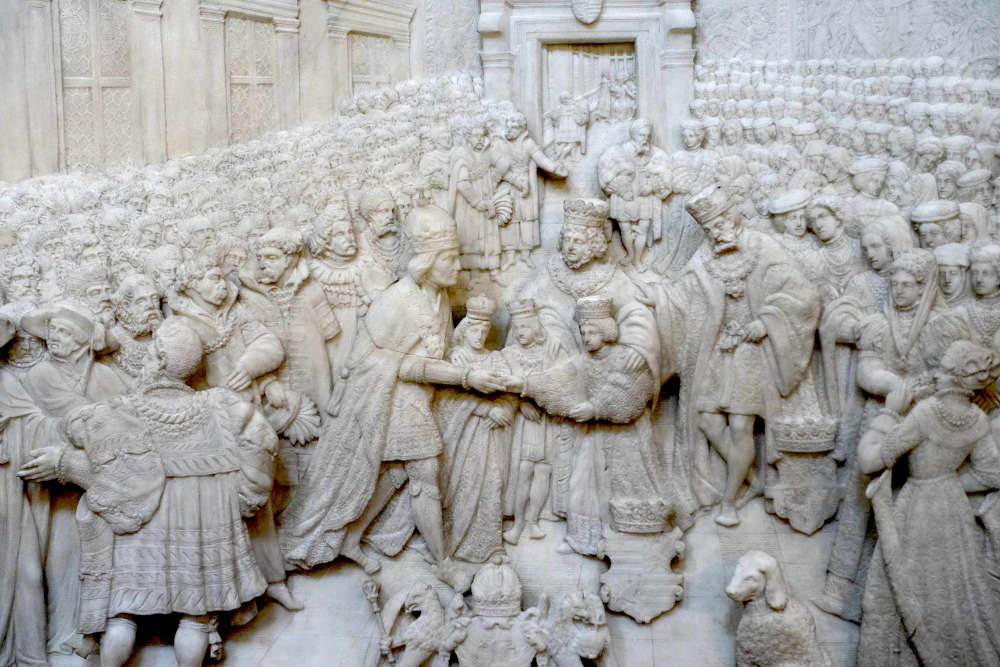
Symbolic depiction of the Vienna double wedding on 22 July 1515 at the tomb of Maximilian I in Innsbruck’s Court Church. Photo: KW.
The Hungarian Crown
While Ferdinand succeeded in Bohemia, the Hungarian magnates elected one of their own to rule their kingdom in November 1526: John Zápolya, Voivode of Transylvania, brother-in-law of the Polish king, one of the richest magnates and, as of then, King of Hungary.
When Ferdinand convened his own assembly of the estates in December, only a few delegates turned up. Nevertheless, he had them elect him King of Hungary. The following summer he invaded his own country with his army. Zápolya lost all military power and with it the support of the estates. Ferdinand was crowned on 3 November 1527 with the Crown of Saint Stephen.

Contemporary depiction of the first siege of Vienna in 1529 on the tomb of its defender Nicholas II, Count of Salm. Photo: KW.
The Habsburgs Become Archenemies of the Turks
To remain king, Zápolya turned to the Ottoman Sultan for support. He swore an oath of allegiance to him on the battlefield of Mohacs in the summer of 1529. And Suleiman the Magnificent fulfilled his part of the bargain, driving the Habsburgs out of Hungary. It was only when they reached Vienna that his army of 150,000 men came to a halt. When the siege failed, the Ottoman army withdrew. This allowed the Habsburgs to regain control of parts of Hungary.
The Turks tried again in 1532. Once again, they were defeated. This prompted Zápolya to change sides once again. He made a secret treaty with Ferdinand in which they de facto agreed to divide the land between them. After Zápolya’s death, the territory would return to Habsburg rule and Zápolya’s family would be compensated.
The French king, however, had his own plans. The war suited him because it diverted resources that the Habsburgs could not use against him in Italy. For this reason, Francis I sent an official legation to Constantinople for the first time in the summer of 1536. We do not know whether they actually concluded an alliance and trade treaty with Suleiman, as Habsburg sources have it. In any case, the mere possibility of such a treaty was taken very seriously in Vienna. They feared a new attack of the Turks, and Ferdinand had to prepare for it. The first step was to mobilise funds to hire mercenaries for the impending war.
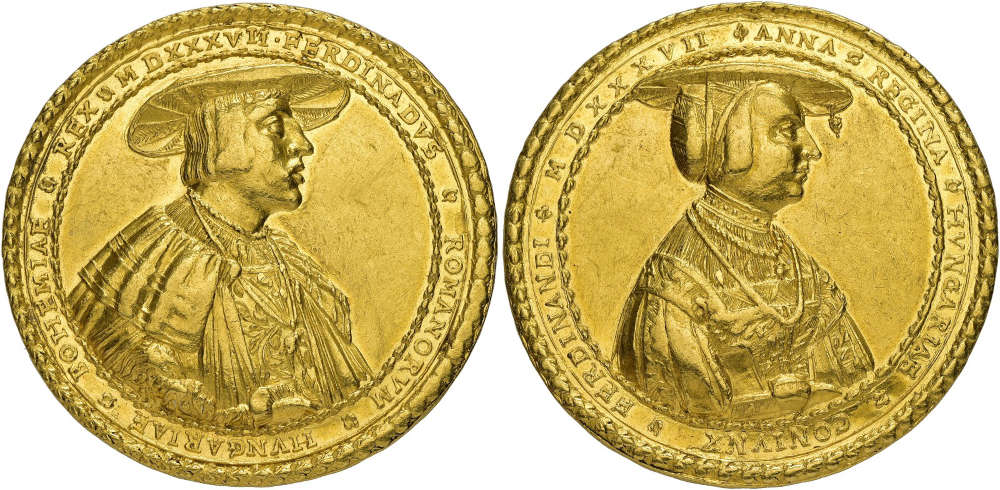
Ferdinand I. 1537 representative coin of 15 gold gulden, Joachimsthal. Commemorating the 10th anniversary of his reign as King of Bohemia and Hungary. The only known specimen made of gold. Slightly worked, as was usual at the time. NGC AU Details. Starting price: CHF 150,000. From SINCONA auction 90 (13-15 May 2024), No. 1561.
A Gnadenpfennig of 15 Gulden
It is very likely that the representative coin on offer at SINCONA – which at the time of its creation would have rather been called a ‘gnadenpfennig’ – is linked to this historical context. The obverse shows the portrait of Ferdinand I, and the reverse that of his wife Anne. The (translated) circumscriptions read: Ferdinand, King of the Romans, the Hungarians and the Bohemians 1537 and Anne, wife of Ferdinand, Queen of the Hungarians 1537.
The portraits are particularly noteworthy as the depicted clothes, jewellery and details refer to the gnadenpfennigs of 1522/23, which had probably been created by Hans Daucher shortly after the wedding. One may well wonder why Wolf Milicz did not use a more up-to-date portrait of the ruling couple as his model. The answer may lie in practical reasons – new portraits were not always and everywhere at hand. However, the use of the old portraits may also have been a deliberate decision to remind the recipients of the gnadenpfennigs of the time when Ferdinand ascended the throne. Everyone remembered that Ferdinand had only been able to become king because Louis II did not have the financial means to fight off the Ottomans. The Fuggers had even started a rumour at the time that it was the king’s lack of creditworthiness that caused his death. This depiction was therefore a reminder of the crucial role that finances played in the fight against the Turks.
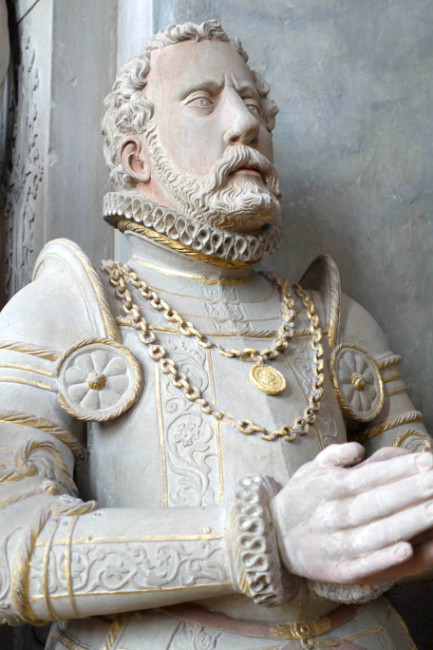
This knight proudly wears a gold gnadenpfennig, which is highlighted in colour, on an elaborate gold chain. Tomb of Echter von Mespelbrunn in Hessenthal. Photo: KW.
The General Diet in Bohemia
Getting this message across was crucial for Ferdinand I in 1537. After all, he had summoned the Bohemian estates to a General Diet in Prague in March 1537. At this meeting, the sovereign wanted the estates to allow him to levy a war tax of 100,000 ‘schock’ of Meissner groschen to raise an army of 10,000 men. The ‘schock’ was a Saxon-Bohemian unit of account and corresponded to 60 pieces. This means that Ferdinand was asking for funds amounting to 6,000,000 Meissner groschen.
What kind of diplomatic work was involved in such a Diet? In addition to the actual sessions, there were many personal meetings in which royal envoys, and occasionally even the ruler himself, would try to persuade a delegate to support their position. Gnadenpfennigs played a major role in these efforts. While they had originally been created to reward those who had rendered a service to the person depicted on them, gnadenpfennigs were often used as diplomatic gifts in the hope of persuading the honoured person to render such a service in the future.
We can therefore assume that Ferdinand I and his envoys distributed gnadenpfennigs in 1537 in order to convince the assembly of their position. In the end, the delegates granted him 25,000 ‘schock’ of Meissner groschen – only a quarter of the amount he had originally requested, but still a lot of money.

Ferdinand I. Representative coin of 10 gold gulden from the dies created in Hall for two different issues – dated 1531 and 1550 respectively. The only known specimen made of gold. Edge slightly worked, as was usual at the time. Extremely fine. Estimate: CHF 150,000. From SINCONA auction 90 (13-15 May 2024), No. 1560.
A Worn Token of Favour – And a Talented But Luckless Engraver
In the 16th century, gnadenpfennigs were essential status symbols: those who had received a gnadenpfennig would wear them on a long golden chain or attach it to their headgear to show everyone that an important ruler had granted them his favour. For this reason, gnadenpfennigs are usually slightly worked so they could fulfil their function as an accessory. This is typical of the period and thus an excellent indicator for the authenticity of a piece.
The second representative on offer at SINCONA also bears such traces. The coin is a particularly attractive piece. The obverse shows the armoured and crowned busts of Emperor Charles V and Ferdinand I facing each other. At the top we can read Charles’ motto – Plus Ultra (= beyond) –, and between the two rulers is the crowned imperial orb. The lower part of the issue is dominated by a large inscription listing the titles. The last line contains the year 1531, and therefore the year in which Ferdinand I was elected and crowned as King of the Holy Roman Empire on the initiative of his brother Charles.
The reverse, on the other hand, shows the year 1550 and depicts the Habsburg double eagle with a magnificent coat of arms.
This aesthetically appealing but historically inaccurate combination was created by Christof Loch junior, a talented goldsmith and engraver, who held a thankless position at the Hall mint: he was not an official of the mint, but was commissioned and paid by mint master Ulrich Ursentaler when necessary. Ursentaler suffered from poor eyesight and left the more delicate work to others, namely his relatives: Christof Loch senior and his son of the same name, who was responsible for this representative coin.
One can imagine that Loch junior hoped to succeed Ursentaler as mint master one day. But this did never happen. Even though a deed of 24 February 1551 promised to employ him as an iron engraver if necessary. But when the time came in 1560, Ursentaler made sure that his own son got the job. This must have been a bitter disappointment to Loch.
Gold representative coins, or rather gnadenpfennigs, from the first half of the 16th century are extremely rare on the market. Most of them were melted down at some point due to financial emergencies or found their way into a museum. The fact that SINCONA is able to offer as many as two of them in auction 90 must be considered a great stroke of luck. It has given us the opportunity to take a closer look at this interesting numismatic phenomenon.







